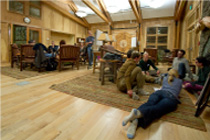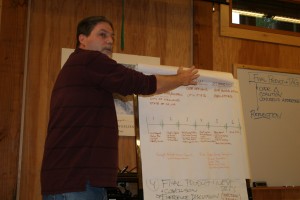What do a proposal for designing, building, and funding high performance affordable housing, the recent aspirational & outcome based energy code proposal to the Washington State’s Building Code Council, and the Building Carbon Zero California Symposia have in common? In each case, EMERGE Alumni are leading the way.
“Elegant and Agile” is what EMERGE Alumni Alistair Jackson (O’Brien & Company), Julie Kriegh (Kreigh Architecture), and Pat Park (21 Acres) call their proposal to increase housing affordability through high performance design, integrated delivery, and incremental funding. The nation’s affordable housing stock has until recently, prioritized quantity over quality, resulting in an inventory which typically becomes economically unsustainable within a decade of completion.  Even as affordable housing leaders strive to make performance a priority, they are thwarted by a funding process that deters early stage investment in design integration, and offers few incentives for investors to favor long-term performance and hence economic, social and environmental sustainability. The EMERGERs proposes a new approach that makes economic and social sustainability the primary goal and total cost of ownership the primary metric of success, and which is applicable to both new construction and rehabilitation of existing housing stock. While drawing on existing high-performance examples, it introduces an innovative delivery process. When the team shared their proposal with the local Housing Development Consortium, the group was so impressed they scheduled a repeat presentation to a larger audience; an expanded session is scheduled for the Living Future unConference in Portland in May, 2014.
Even as affordable housing leaders strive to make performance a priority, they are thwarted by a funding process that deters early stage investment in design integration, and offers few incentives for investors to favor long-term performance and hence economic, social and environmental sustainability. The EMERGERs proposes a new approach that makes economic and social sustainability the primary goal and total cost of ownership the primary metric of success, and which is applicable to both new construction and rehabilitation of existing housing stock. While drawing on existing high-performance examples, it introduces an innovative delivery process. When the team shared their proposal with the local Housing Development Consortium, the group was so impressed they scheduled a repeat presentation to a larger audience; an expanded session is scheduled for the Living Future unConference in Portland in May, 2014.
Mike Fowler manages the PSE Residential New Construction Energy-Efficiency Incentive program. He’s an Architect with 20+ years of experience focused on energy efficiency including two net-zero energy design projects, five LEED projects and past service as a member of the Washington State Building Code Council (SBCC) Energy Code – Technical Advisory Group (TAG). He’s currently Chair for the AIA WA Codes and Planning Policy Committee and a member of the SBCC Green Building TAG. In early 2012 he authored an Outcome-based Energy Budget code proposal that focuses on reducing actual energy use 70% by 2031, and his hope was to use the December 2012 EMERGE Leadership Workshop as a springboard for effectively taking this proposal forward in 2013, and enhancing his leadership skills to help him do so.
 Mike was confident about the technical content of his proposal, but he wanted help thinking about the process of building support for his proposal. It didn’t hurt that David Eisenberg was co-faculty for the workshop. David is well-known for his work “greening” codes nationally and internationally. But the piece de resistance was the workshop’s team scenario component. Imagine Mike’s pleasure when his project (slightly altered for wider applicability) was offered to workshop attendees as a planning scenario! Mike and several attendees (and David) worked together using emergent leadership concepts to develop an outline of a plan, complete with timeline, possible allies, and suggested resources. (Photo: Mike is presenting the outline at EMERGE.)
Mike was confident about the technical content of his proposal, but he wanted help thinking about the process of building support for his proposal. It didn’t hurt that David Eisenberg was co-faculty for the workshop. David is well-known for his work “greening” codes nationally and internationally. But the piece de resistance was the workshop’s team scenario component. Imagine Mike’s pleasure when his project (slightly altered for wider applicability) was offered to workshop attendees as a planning scenario! Mike and several attendees (and David) worked together using emergent leadership concepts to develop an outline of a plan, complete with timeline, possible allies, and suggested resources. (Photo: Mike is presenting the outline at EMERGE.)
But it didn’t stop there. By its nature, EMERGE brings together green building professionals who are already highly committed to taking a leadership role in the sustainable transformation of our built environment. Although participants may be at various points in their career, all of them are bright and talented and bring this to the workshop experience. One of the “favorite” reported benefits reported on workshop evaluations is the role EMERGE plays in connecting these talented and dedicated individuals, and building a leadership community they can rely on.
When Mike contacted me for support of his updated proposal this fall, which now incorporated peer review feedback from a number of Emerge alumni, other focus groups, and a new focus toward an Aspirational Code (a new code vision for Washington State), the next step was obvious. An email sent out to EMERGE Alumni asking for letters to the SBCC supporting his proposal generated (in Mike’s words), “an amazing response.” No doubt this played a very large part in Mike’s success in making a case for serious consideration of his proposal as the SBCC formally approved development of an Aspirational Code work plan that incorporates his proposal and outcome-based codes as one of the possible options.
Connecting committed leaders and supporting their collaboration is definitely key for Bronwyn Barry’s respect for the EMERGE experience. Bronwyn, an architect, is Director of One Sky Homes, and Founding Board Member of Passive House California, and very active in Passive House International. After meeting Bill Worthen (of Urban Fabrick and former Director, Resource Architect for Sustainability, AIA) and Bill Burke (of PG&E’s Pacific Energy Center) in the January 2013 workshop, she was able to reframe and enlarge the conversation that individually groups focused on net zero energy, Passive House, etc. were having. While the “Building Carbon Zero California Symposia” featured Passive House Heroine, Joke Dockx, from the City of Brussels, it also featured a panel hosted by Bill Worthen who assembled an expert panel of local net zero luminaries. The goal of the event, says Bronwyn, was to “gather all the players — city planners, public utility and state energy commission representatives, architects, builders, and facilities managers — to find a way to work together to work on the larger goal of creating a built environment that is ‘carbon-zero’.” Since the initial symposium, a “spin-off” event has been held in Marin County, focused specifically on local issues, and a “series” of similar events are in the works to serve as local catalysts for more effective collaboration.
Clearly, the EMERGE Leadership workshop draws to it very special people. But its fair to say that in bringing these individuals together and providing tools and context for leadership it creates something much more.